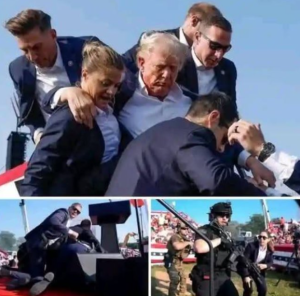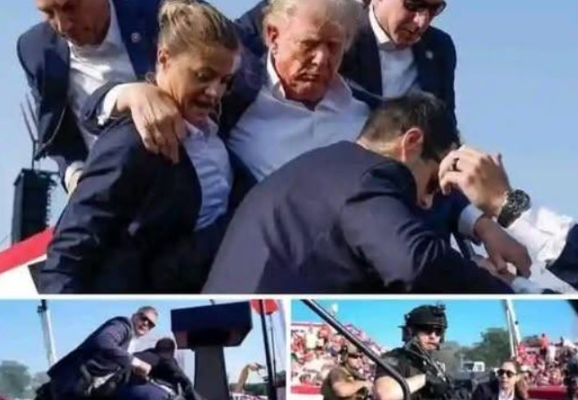
False Claim: “Donald Trump Shot While Exiting the White House”
In recent hours, a story has been circulating online claiming that former U.S. President Donald Trump was “shot again while exiting the White House.” The language in these posts is alarming and designed to grab attention. However, after carefully reviewing credible reports, official statements, and major news outlets, there is no evidence whatsoever that such an event occurred. What this highlights is how quickly misinformation can spread, especially when it involves a figure as high-profile as a former U.S. president.
The Reality Behind the Rumor
On multiple social media platforms, including small blogs and personal accounts, messages appeared claiming that Trump had been the victim of another shooting incident in Washington, D.C. The messages often used sensational language such as “breaking news,” “just happened,” or “unbelievable attack,” but they lacked key elements of real journalism: credible sources, official confirmation, and detailed reporting.
Major national and international news outlets did not publish any reports confirming the alleged shooting. Organizations such as The Associated Press, Reuters, and CNN — which always cover major political incidents within minutes — had no coverage of any shooting involving Trump at the White House. This is a critical sign that the story is not true.
What Did Happen Near the White House
To understand how this rumor might have started, it’s important to look at a real event that occurred in March 2025. On that day, the United States Secret Service shot an armed man who approached a security checkpoint near the White House. The man allegedly brandished a firearm, leading to a swift response from security personnel. Importantly, Donald Trump was not at the White House at the time of that incident, and he was not injured.
This legitimate security event may have been misrepresented or twisted online into a false story about Trump being shot. Misinformation often grows in this way: a kernel of truth is exaggerated or distorted, creating a new, fake narrative.
A Real Assassination Attempt — But Not at the White House
There was, however, a real and confirmed assassination attempt on Donald Trump in July 2024 at a campaign rally in Pennsylvania. During that event, a gunman opened fire, and Trump was struck in the ear by a bullet. One spectator died and others were injured. This attack was widely covered by news organizations around the world, and official investigations were conducted.
It’s possible that some people online are confusing this real attack with new rumors, or deliberately blending details to create a false sense of breaking news.
How Misinformation Spreads
False stories like this don’t happen in a vacuum. There are several common patterns:
-
Sensational headlines: Misinformation posts often use alarming or shocking phrases like “BREAKING,” “just now,” or “unbelievable.”
-
No credible source: These posts usually don’t include links to official government statements, credible news outlets, or press briefings.
-
Viral sharing: Emotional or shocking claims tend to be shared quickly, especially in private chats, group pages, or unverified news sites.
-
Blending truth with fiction: Many fake stories mix real past events (like the 2024 rally shooting) with false claims to make their story seem believable.
Once a rumor gains momentum, it can travel faster than the truth — particularly on social media platforms where posts can be shared thousands of times within minutes.
Why False Claims About Violence Are Dangerous
Spreading false information about an attack on a political figure can have serious consequences. It can:
-
Cause panic among the public and destabilize communities.
-
Undermine trust in official institutions if people believe the government is “covering up” events that never happened.
-
Distract from real security issues that need attention.
-
Increase political tension and fuel hostility between groups.
Because of these risks, incidents involving national leaders are always carefully investigated, documented, and reported by major news agencies.
How Real Incidents Are Confirmed
When an actual attack on a high-profile figure like a former president occurs, there are always immediate responses from several sources:
-
Official statements from the Secret Service, White House, or Department of Justice.
-
News alerts from multiple major media outlets.
-
Press conferences and visible security measures.
-
Updates from hospitals or emergency services, if there are injuries.
The absence of any of these signs is a strong indicator that a breaking-news claim is false. In this case, none of these indicators appeared — confirming the story is fabricated.
Why Trump-Related Stories Spread So Fast
Donald Trump is one of the most polarizing figures in modern American politics. Whether people support or oppose him, his name attracts immediate attention. As a result:
-
False stories involving him can reach millions of readers in a very short time.
-
People with political motives sometimes deliberately invent or amplify claims to manipulate public opinion.
-
Sensational posts get more engagement, which encourages clickbait websites to spread them further for advertising revenue.
How to Protect Yourself from False News
Anyone can help stop the spread of fake stories by taking a few simple steps before sharing:
-
Check credible news outlets — If a story is real, major organizations will report it quickly.
-
Look for official statements from law enforcement or government agencies.
-
Be skeptical of sensational language — words like “shocking” or “unbelievable” are often used to manipulate emotion.
-
Avoid reposting unverified content, even if it seems dramatic or urgent.
-
Compare multiple sources to confirm whether the same facts are reported consistently.
The Importance of Media Literacy
In an age of instant communication, media literacy is more important than ever. That means:
-
Understanding how information is produced.
-
Recognizing signs of credible reporting.
-
Identifying red flags that indicate a story might be fake.
-
Taking responsibility for what we share with others.
When people share false stories about violence or attacks, they may unintentionally amplify fear or help spread harmful lies.
What Actually Happens When Threats Occur
Whenever there is any threat near the White House or to a former president, the Secret Service acts immediately. The area is locked down, emergency alerts are issued, and press conferences often follow. This was the case in March 2025, when an armed man was stopped near the White House. These real security events are documented in official records and covered by multiple news organizations, making it easy to distinguish between fact and rumor.
In the current case, no alerts were issued, no major news organizations reported any shooting, and no official statements were released indicating that Trump was harmed. Therefore, the claim is false.
Final Thoughts
The false story claiming that Donald Trump was “shot while exiting the White House” is an example of how fake news can spread quickly and cause unnecessary alarm. It likely originated from a distortion of real security incidents and old assassination attempt coverage.
The truth is clear:
-
There has been no new attack on Donald Trump at the White House.
-
The last confirmed attempt on his life occurred at a Pennsylvania rally in July 2024.
-
An unrelated security incident happened near the White House in March 2025, but Trump was not present.
-
No credible news outlet or official agency has confirmed any new attack.
In times like this, the best response is not panic, but verification. Check reliable sources, question dramatic claims, and resist the urge to share stories before confirming their accuracy. By doing so, each of us can play a role in reducing misinformation and promoting truth in an increasingly noisy information environment.

